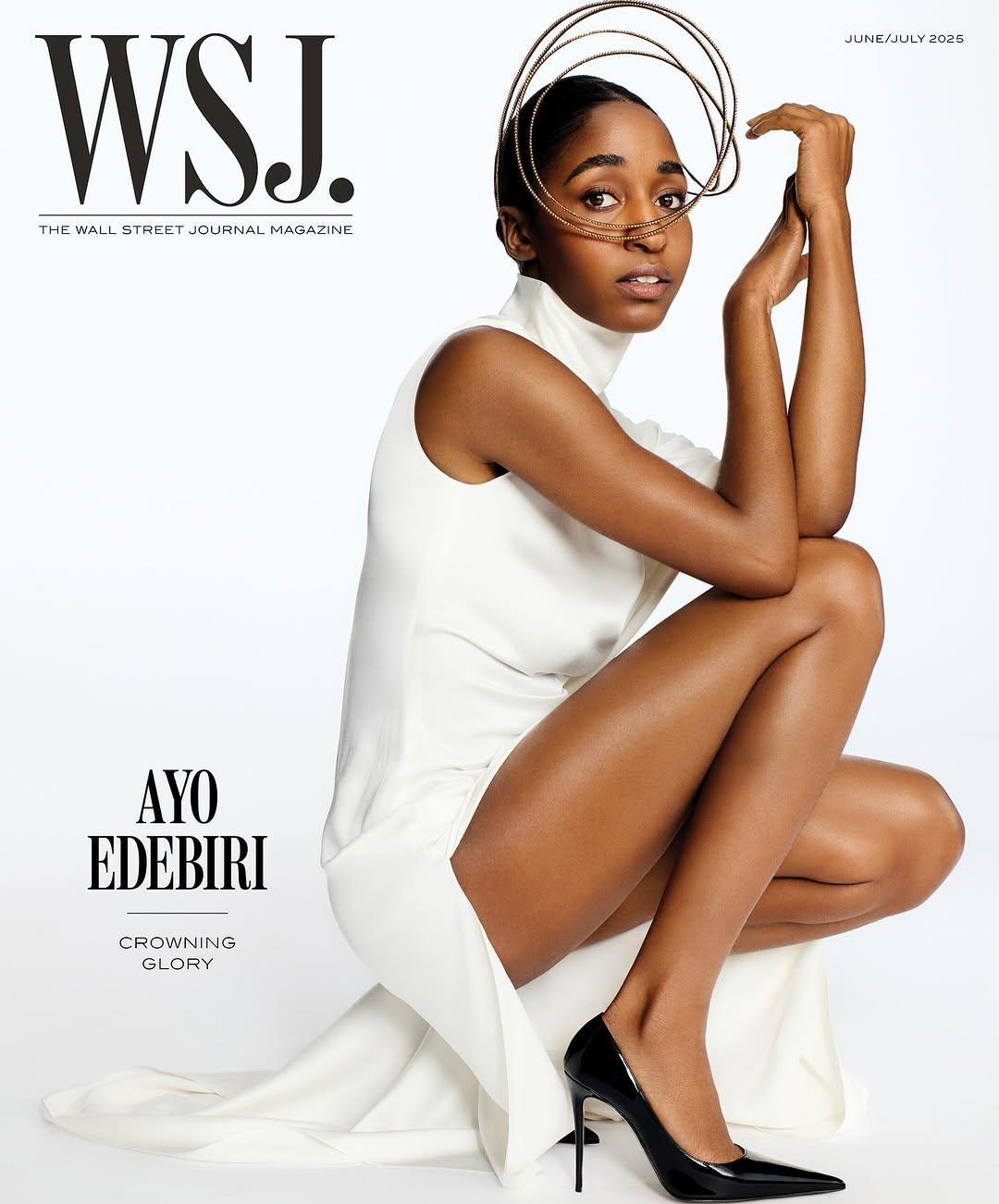

Ayo Edebiri, the Emmy-winning star of The Bear and one of the most captivating voices in comedy and screenwriting today, takes center stage in the June/July 2025 issue of WSJ. Magazine. Photographed by the inimitable Ethan James Green and styled by legendary fashion editor Tonne Goodman, the editorial captures a side of Edebiri that blends her grounded charm with high-concept fashion artistry. With words penned by Recho Omondi, the feature is as intellectually stimulating as it is visually arresting–a tribute to a rising icon who bridges entertainment, introspection, and quiet rebellion.
On the cover, Edebiri crouches elegantly in a white Stella McCartney dress, its clean lines framing her figure like a sculpture in motion. The look is completed by a geometric, almost futuristic headpiece by Lynn Paik, which lends an avant-garde silhouette to the shot, and a pair of pointed Christian Louboutin heels that shimmer beneath the hem. The image, lit with Green’s signature moody softness, is both vulnerable and commanding-ha metaphor for Edebiri’s place in pop culture. It’s fashion as armor, expression, and meditation.
The editorial unfolds with even more boundary-pushing looks. In one striking photograph, Edebiri wears a multicolored dress that cascades in layers of texture and hue, eliciting split reactions online. Some praised the dress as a vibrant statement of joyful maximalism, while others noted it felt like it wore her rather than the other way around. Still, the choice reflects the editorial’s overarching ethos: challenging expectations and allowing space for complexity. Edebiri does not play muse in the traditional sense; instead, she brings her own enigmatic energy to each frame, often making the garments feel like collaborators rather than costume.
Another look places Edebiri in a sleek, rose-pink ensemble that stands out for its tactile beauty and warmth. The soft, glistening fabric wraps around her in a way that evokes both softness and structure. Fans on platforms like Reddit praised the material and color, remarking on how the outfit felt more in sync with Edebiri’s natural magnetism. It’s a moment that captures the balance Goodman’s styling strives for throughout the shoot: the merging of conceptual couture with a personality that doesn’t need embellishment.
But it’s not just the fashion that makes this spread compelling. In the accompanying interview, Edebiri opens up with rare candor, dissecting her relationship with privacy, identity, and the pressures of being perceived in a digital age. “I’m not going to show you guys my personal life, because you’re so weird about my work life,” she states pointedly–a line that has resonated widely online. She also reflects on her upbringing as a Nigerian-Barbadian girl in Boston, her early ambitions in comedy, and her evolving relationship with fame. “I’m that African. It is finished. It’s done. I cannot help you anymore,” she says with a smile, showing that her dry humor remains intact even in the context of high fashion.
Reactions to the shoot have been passionate and varied across social media and fashion forums. Some praise the styling as daring and editorially sharp, appreciating the risks taken with color, silhouette, and form. Others feel the looks occasionally veer into the abstract, momentarily overshadowing Edebiri’s own natural charisma. Yet, this tension only elevates the shoot’s relevance. It’s not about playing it safe–it’s about pushing the image of a modern actress beyond the typical mold.
Ultimately, this WSJ. Magazine feature is not just a fashion spread. It’s a mood board for modern stardom, a visual essay on duality and discretion. Through the lenses of Green, Goodman, and Omondi, Ayo Edebiri emerges not just as an actress or writer, but as a symbol of what it means to own one’s narrative–on the page, on screen, and in the glossy pages of high fashion.



